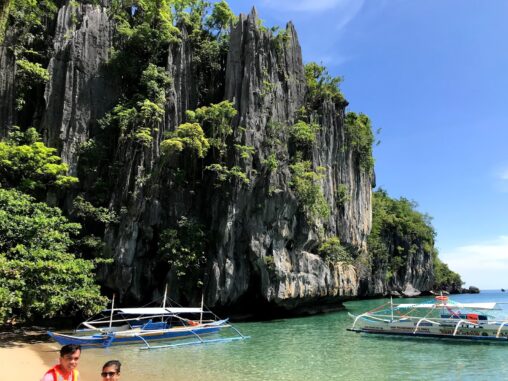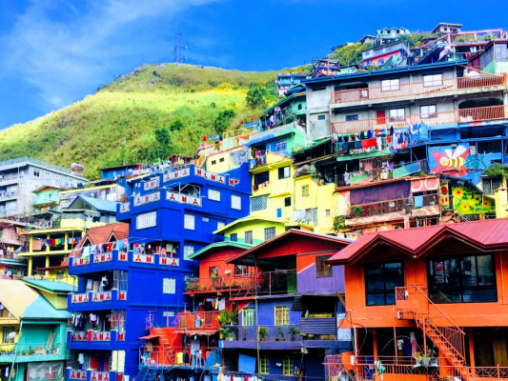
THE PHILIPPINES TRAVEL GUIDE

The Philippines offers a wealth of fascinating sights and activities to explore.
The stunning islands of the archipelago, such as Palawan, Boracay, and Cebu, are perfect for boat tours and island-hopping adventures. Imagine cruising through the turquoise waters of El Nido’s Big Lagoon, snorkeling in the vibrant coral reefs of Apo Island, or relaxing on the powdery white sands of Boracay’s White Beach. Meanwhile, vibrant cities like Manila and Cebu boast incredible food scenes, rich history, and breathtaking Spanish colonial churches and landmarks waiting to be discovered.
Dive into this Philippines travel guide for my top tips and essential information to make the most of your trip! Whether you’re seeking pristine beaches, lush jungles, or cultural experiences, the Philippines has something for every traveler. Don’t miss the chance to explore this tropical paradise and create unforgettable memories!
 Language, Tagalog
Language, Tagalog
 Religion, Catholic
Religion, Catholic
 Currency, Peso
Currency, Peso
 Capital, Manila
Capital, Manila
 Visa, free for 70+ destination
Visa, free for 70+ destination
 Climate, tropical, hot, humid
Climate, tropical, hot, humid
 Power plugs, Type A / B / C
Power plugs, Type A / B / C
 Apps, Roamless
Apps, Roamless

The Philippines is well-connected to the world through its main international airports, Manila (MNL) and Cebu (CEB), which offer direct flights from numerous countries across Asia and beyond. These hubs serve as the primary gateways for travelers looking to explore the country’s stunning destinations.
For those venturing to popular tourist spots, the Philippines also has domestic airports in key locations such as Bohol, Coron, El Nido, and Siargao, making it easy to hop between islands and experience the country’s diverse beauty.
To find the best deals on flights to the Philippines, you can compare prices and book your tickets on Expedia, a reliable platform for planning your journey. Whether you’re flying internationally or domestically, getting to your dream destination in the Philippines has never been easier!

The Philippines is a generally safe destination for travelers, with a welcoming culture and a strong sense of community. While petty crimes like pickpocketing can occur in crowded areas, violent crime rates are relatively low compared to global averages. Having explored many parts of the country, I’ve found Filipinos to be incredibly friendly and helpful, making it easy to feel at ease during your travels.
That said, the primary safety concerns in the Philippines are related to transportation, such as road accidents, and natural risks, including typhoons and dengue fever. To stay protected, especially in rural or tropical areas, it’s essential to use mosquito repellent, stay updated on weather advisories, and exercise caution when traveling by motorbike or local transport. By taking these simple precautions, you can enjoy a safe and unforgettable trip to this stunning archipelago.
The Philippines is a country of breathtaking beauty and warm hospitality, and with a little preparation, your journey will be as smooth as it is memorable.

The Philippines enjoys a tropical climate, characterized by warm temperatures and high humidity year-round. In popular destinations like Palawan, Boracay, and Cebu, the rainy season typically spans from June to October, while the dry season runs from November to May.
Traveling during the rainy season can still be a fantastic experience, as the showers are often brief and followed by sunshine. However, it’s wise to plan for a few extra days as a buffer in case of unpredictable weather, especially if you’re visiting coastal or remote areas. This way, you can make the most of your trip, rain or shine, and still enjoy the Philippines’ stunning beaches, lush landscapes, and vibrant culture.
Whether you visit during the sunny or rainy season, the Philippines promises unforgettable adventures and breathtaking scenery!

The Philippines is an incredibly budget-friendly destination, offering affordable accommodations and dining options. Hostels and budget hotels can start as low as ₱500–₱1,000 (10–10–20 USD) per night, while mid-range private hotels typically range from ₱1,500–₱3,000 (30–30–60 USD). Meals are equally economical, with local dishes like adobo, sinigang, and lechon costing between ₱100–₱300 (2–2–6 USD) at carinderias (local eateries) or street food stalls.
For getting around, transportation options include renting a motorbike, taking tricycles or jeepneys (local modes of transport), or hiring a private van for longer trips. Ride-hailing apps like Grab are widely available in major cities like Manila and Cebu, offering a convenient and reliable way to travel. However, in more remote areas, tricycles or habal-habal (motorcycle taxis) are the go-to options.
Despite the occasional need to navigate different transport systems, the Philippines remains an accessible and cost-effective travel destination for all types of travelers. Whether you’re exploring its pristine beaches, vibrant cities, or lush mountains, you’ll find that your money goes a long way in this tropical paradise!

My latest blog posts about The Philippines

Palawan Paradise: A Journey Through Pristine Beaches, Hidden Lagoons, and Tropical Wonders

A Serene Escape to Baguio: Exploring Nature, History, and Culture








